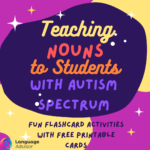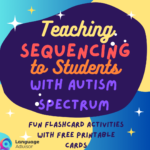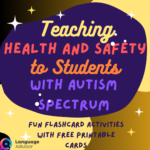Teaching Colors to Students with Autism Spectrum: Fun Flashcard Activities and Free Printable Flashcards
Teaching Colors to Students with Autism Spectrum

Teaching Colors to Students with Autism Spectrum
Learning colors is an essential skill for young learners, and using flashcards is an engaging way to help students on the autism spectrum recognize and understand different colors. Flashcards offer a simple, interactive, and visual learning experience that can help students build vocabulary, improve attention, and develop communication skills.
In this blog post, we’ll explore how you can use color flashcards to teach colors to students with autism in a fun and interactive way. Plus, you’ll be able to download free printable color flashcards at the end of this post, ready to use in your classroom or at home!

Why Are Colors Important to Learn?
Understanding colors is a key part of language development and helps students with:
- Communication: Learning the names of colors allows students to describe objects, express preferences, and follow directions more easily.
- Categorization: Recognizing colors helps students group similar objects, improving their organizational and problem-solving skills.
- Visual Perception: Color recognition sharpens students’ visual skills, helping them notice differences and similarities in their environment.
For students with autism, learning colors through visual tools like flashcards can be especially effective, as many students on the spectrum are visual learners.
Fun Activities Using Color Flashcards
Here are some fun ways you can use them to teach colors to your students:
1. Color Matching Game
Start by showing your student two or more color flashcards. Then, hold up an object that matches one of the cards (for example, a red ball). Ask the student to match the object to the correct flashcard.
Tip: Begin with just two or three colors to avoid overwhelming the student, then increase the number of flashcards as they become more comfortable.
2. Color Hunt
Once students start recognizing different colors, you can turn it into a game! Show them a color flashcard and ask them to find something in the room that matches the color. This activity is great for helping students practice color recognition in real-world situations.
Tip: Encourage students to touch and explore different objects during the hunt to engage their sensory system and reinforce learning.
3. Color Sorting
Create a simple sorting activity by placing several color flashcards on the table. Then, provide a mix of objects in different colors (such as buttons, toys, or crayons) and ask the student to sort them by matching the objects to the correct flashcards.
Tip: Start with basic colors like red, blue, and yellow, and gradually add more shades as the student masters the basics.
4. I Spy With Colors
Using the color flashcards, play a game of “I Spy” to help students practice color recognition. Hold up a flashcard and say, “I spy something [color]!” Have the student point out objects in the room that match the color you named.
Tip: This game can also be played outdoors or during walks, turning it into a fun way to teach colors in different environments!
5. Show Me the Color
Hold up different color flashcards and ask the student to show you an object of that color from their surroundings. This helps build connections between the abstract idea of a color and concrete objects, reinforcing color identification.
Tip: Use a variety of everyday objects to make the activity feel more relatable to the student’s environment.
6. Color Flashcard Memory Game
Place several flashcards face down on the table. Flip over two at a time and see if they match. If they don’t, turn them back over and let the student try again. This game is great for building memory and concentration while reinforcing color recognition.
Tip: Use just a few pairs at first, and increase the number of flashcards as the student gets better at remembering where the colors are.

How to Use These Activities
Here are a few tips to make color learning effective and enjoyable:
- Start with primary colors: Introducing red, blue, and yellow first helps students grasp the basics before moving on to more complex colors.
- Keep it visual and hands-on: Use real-world objects to complement the flashcards and give students tangible ways to interact with color.
- Repeat and reinforce: Repetition is key for learning colors, so revisit the flashcards and activities regularly.
- Praise and celebrate progress: Celebrate even small successes! This will boost the student’s confidence and make learning feel rewarding.
Teaching Colors to Students with Autism Spectrum: Final Thoughts
Teaching colors to students with autism can be both fun and rewarding when using flashcards and interactive games. These activities help students develop important cognitive and communication skills while making the learning process enjoyable and engaging.
Don’t forget to download the free printable flashcards to start practicing colors with your students today.
Let us know how these activities worked for your class and feel free to share any success stories in the comments below!

Teaching Colors to Students with Autism Spectrum
DOWNLOAD THE PDF FOR FREE
Teaching Colors to Students with Autism Spectrum
DOWNLOAD THE POWER POINT FOR FREE





